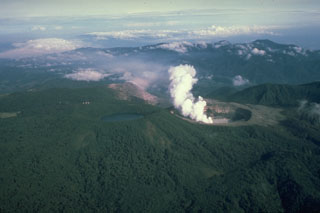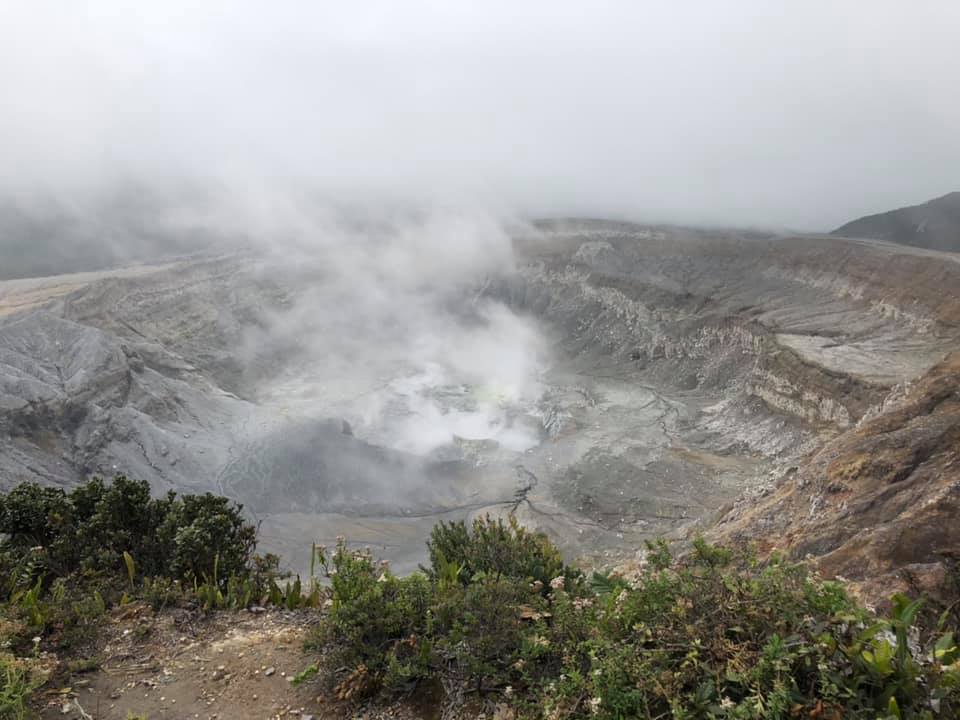Report on Poas (Costa Rica) — October 2019
Bulletin of the Global Volcanism Network, vol. 44, no. 10 (October 2019)
Managing Editor: Edward Venzke.
Research and preparation by Paul Berger.
Poas (Costa Rica) Occasional phreatic explosions continue through September 2019
Please cite this report as:
Global Volcanism Program, 2019. Report on Poas (Costa Rica) (Venzke, E., ed.). Bulletin of the Global Volcanism Network, 44:10. Smithsonian Institution. https://doi.org/10.5479/si.GVP.BGVN201910-345040
Poas
Costa Rica
10.2°N, 84.233°W; summit elev. 2697 m
All times are local (unless otherwise noted)
Activity at Poás is characterized by weak phreatic explosions and gas-and-ash-emissions, with a hot acid lake that occasionally disappears (BGVN 44:05). During the current reporting period of May-September 2019, this weak activity continued. The volcano is monitored by the Observatorio Vulcanologico Sismologica de Costa Rica-Universidad Nacional (OVSICORI-UNA), and most of the material below comes from their weekly bulletins (Boletin Semanal Vulcanologia).
According to OVSICORI-UNA, a period of continuous emissions occurred during 30 April-1 May with plumes rising 300 m above the crater rim and drifting SW. Ash emissions were visible for a few hours on 30 April, and incandescence was visible at night. OVSICORI-UNA did not report any additional phreatic explosions in May until daily phreatic, geyser-type explosions were observed between 29 May and 1 June, which reached approximately 100 m above the vent. A phreatic explosion on 10 June reached approximately 20-30 m in height, and frequent small phreatic explosions (heights below 20 m) were reported through 16 June.
OVSICORI-UNA reported that on 12 June small geyser-like explosions ejected material less than 50 m high at a rate of about once per hour. At 0604 on 18 June an explosion that lasted about six minutes produced a plume of unknown height. Residents reportedly heard several loud noises during 0610-0615 and observed a plume rising from the crater. Ash fell in Cajón (12 km SW), San Luis de Grecia (11 km SW), Los Ángeles, San Miguel de Grecia (11 km SW), San Isidro (28 km SE), and San Roque (23 km SSE). Whitish ash deposits surrounding the crater, especially on the W and S sectors, were visible in webcam images. On 21 June frequent small phreatic explosions from vent A (Boca Roja) were visible during good viewing conditions ejecting material less than 10 m high.
No additional phreatic activity was reported by OVSICORI-UNA during rest of June or July. The small crater lake was still present on 5 July when visible in satellite imagery and as seen by visitors (figure 130), During the first part of August geyser-like explosions occurred on several days, and reached a maximum height of 50 m. This activity culminated on 17 August with about 30 explosions/day from the vent (Boca Roja). At least one event at 0650 on that day generated a 1-km-high plume of steam, gas, and fine particles. By 26 August, the geyser-type activity had ceased. Geyser-type phreatic explosions resumed on 12 September, reaching a maximum height of 30 m. The number of explosions increased up to 10-15 events/hour and then became continuous for a short time. A phreatic explosion occurred on 22 September at 2059 that generated a plume that rose 3 km above the crater rim and drifted NE. During 22-23 September explosions generated plumes that rose 1 km.
According to OVSICORI-UNA, during 16-26 September sulfur dioxide emissions drifted W and NE, causing a sulfur odor in Alajuela, Heredia, San José, and Cartago. Acidic rain was recorded at an official's house in the Poás Volcano National Park (PNVP) on 23 September and at the Universidad Nacional Costa Rica (UNA) in Heredia (23 km SE) on 26 September. On 30 September, at 0540, a 5-minute long phreatic explosion ejected sediment, and produced a plume that rose 2 km above the crater rim and drifted SW. Ashfall and a sulfur odor was reported in Trojas de Sarchi (10 km SW) and Grecia (16 km SSW). Officials closed the PNVP because of the eruption and ongoing elevated seismicity; the park remained closed the next day.
During the first week of August, strong evaporation had reduced the intracrater lake significantly, and by mid-September, the lake had disappeared. At the end of September, however, some water had begun to accumulate again.
General monitoring data. During April and May, OVSICORI-UNA took few gas measurements due to an unfavorable wind direction. An SO2 measurement during the first part of June was between 100 and 200 t/d. Flux remained low through July, with low SO2/CO2 ratios, and high H2S/SO2 ratios, which OVSICORI-UNA stated were consistent with water infiltration. At the end of July, SO2 concentrations significantly increased to 300-800 t/d, with H2S disappearing and the CO2/SO2 ratio declining, with some fluctuations. Levels remained high through most of August, but had decreased to about 300 t/d by the end of the month. They rose again in September, with fluctuations, and on 29 September were measured at about 1,000 t/d before falling to between 300-400 t/d.
According to OVSICORI-UNA weekly reports, seismicity was relatively low during the reporting period, with a few VTs and LPs and normal background tremor. No significant deformation occurred, except for some deflation in June and July.
Geological Summary. The broad vegetated edifice of Poás, one of the most active volcanoes of Costa Rica, contains three craters along a N-S line. The frequently visited multi-hued summit crater lakes of the basaltic-to-dacitic volcano are easily accessible by vehicle from the nearby capital city of San José. A N-S-trending fissure cutting the complex stratovolcano extends to the lower N flank, where it has produced the Congo stratovolcano and several lake-filled maars. The southernmost of the two summit crater lakes, Botos, last erupted about 7,500 years ago. The more prominent geothermally heated northern lake, Laguna Caliente, is one of the world's most acidic natural lakes, with a pH of near zero. It has been the site of frequent phreatic and phreatomagmatic eruptions since an eruption was reported in 1828. Eruptions often include geyser-like ejections of crater-lake water.
Information Contacts: Observatorio Vulcanologico Sismologica de Costa Rica-Universidad Nacional (OVSICORI-UNA), Apartado 86-3000, Heredia, Costa Rica (URL: http://www.ovsicori.una.ac.cr/); Sentinel Hub Playground (URL: https://www.sentinel-hub.com/explore/sentinel-playground); Sheila DeForest (URL: https://www.facebook.com/sheila.deforest).


